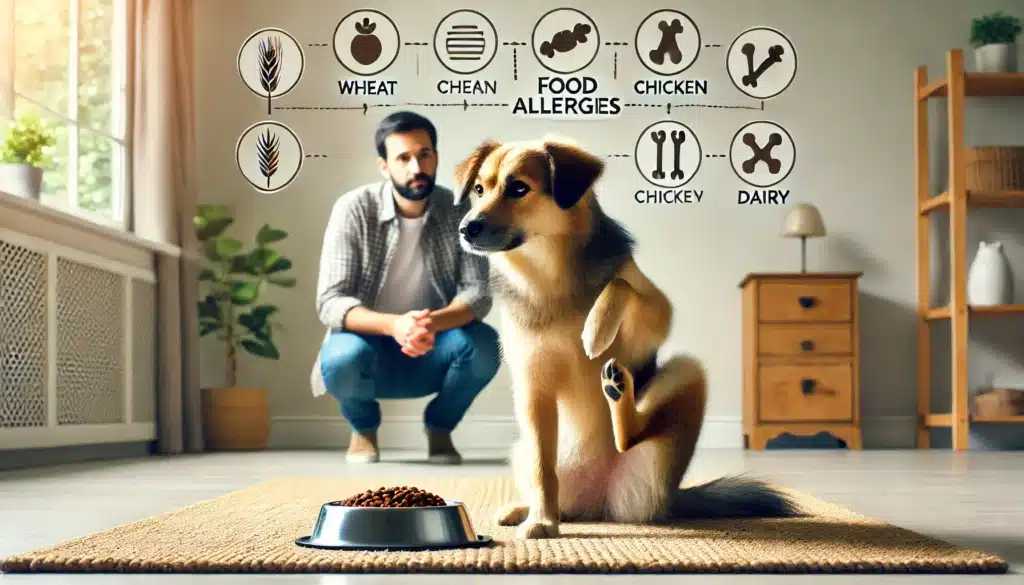Does your dog constantly scratch, lick their paws, or suffer from frequent ear infections? These could be signs of a food allergy — an increasingly common issue affecting dogs of all breeds and ages.
Food allergies are often misunderstood, but recognizing the signs early and taking the right steps can make a huge difference in your dog’s health, comfort, and overall quality of life.
In this guide, we’ll explain what food allergies are, how they differ from sensitivities, the most common symptoms, what causes them, and how to manage your dog’s diet safely and effectively.
What Is a Food Allergy in Dogs?
A food allergy is an abnormal immune response to a specific ingredient — usually a protein — in your dog’s diet. The immune system mistakenly identifies this ingredient as a threat and reacts by triggering inflammation, often in the skin or digestive tract.
Food Allergy vs. Food Intolerance:
- Food Allergy = Immune response (often causes skin problems, itching)
- Food Intolerance = No immune involvement (usually causes digestive upset)
Both require dietary management, but allergies tend to be more persistent and severe.
Most Common Signs of Food Allergies
The symptoms of a food allergy can vary depending on your dog’s immune system and the severity of the allergy.
🐾 1. Itchy Skin (Pruritus)
This is the #1 symptom of food allergies. Dogs may excessively scratch, lick, or bite certain areas:
- Paws
- Ears
- Face
- Belly
- Underarms
- Groin
Itching may be seasonal at first, but with food allergies, it usually becomes year-round.
🐕 2. Ear Infections
Recurrent or chronic ear infections are a classic sign of food allergies, especially in breeds prone to ear issues (like Cocker Spaniels, French Bulldogs, and Labs).
- Red, inflamed ear canals
- Head shaking
- Bad odor
- Dark brown or yellow discharge
💩 3. Digestive Upset
Food allergies can also affect the digestive system. Common symptoms include:
- Diarrhea
- Vomiting
- Gas
- Soft or inconsistent stools
- Increased frequency of bowel movements
🐶 4. Paw Licking or Chewing
Dogs may obsessively lick or chew at their paws — often leading to redness, hair loss, or brown staining from saliva.
🧴 5. Skin Infections and Hot Spots
Scratching and inflammation can damage the skin, allowing bacteria or yeast to take over, resulting in:
- Bald patches
- Scabs or crusts
- Oozing wounds
- Foul odor from the skin
🥱 6. Lethargy and Behavioral Changes
Constant itching, discomfort, and digestive upset can lead to:
- Low energy
- Irritability
- Anxiety
- Reduced playfulness
Less Common (But Possible) Symptoms
- Sneezing or coughing
- Eye discharge
- Nasal discharge
- Red or watery eyes
- Weight loss (in severe cases)
Most Common Food Allergens for Dogs
Contrary to popular belief, grains are rarely the cause of food allergies. The most common culprits are proteins — both animal and plant-based.
Common Protein Allergens:
- Beef
- Chicken
- Dairy
- Eggs
- Lamb
- Fish
- Soy
- Wheat (less common)
Note: A dog can develop an allergy to a food they’ve eaten for years without issue.
How to Identify a Food Allergy
The gold standard for diagnosing food allergies is a food elimination trial.
How It Works:
- Choose a novel protein your dog has never eaten (e.g., venison, duck, rabbit)
- Feed only that protein (and a simple carbohydrate like sweet potato) for 8–12 weeks
- No treats, table scraps, flavored medications, or chews during the trial
- If symptoms disappear, reintroduce old ingredients one by one to identify the allergen
Tips:
- Stick with limited-ingredient or prescription diets
- Monitor symptoms closely and keep a journal
- Don’t assume “grain-free” equals hypoallergenic
- Work with your veterinarian for best results
Managing Food Allergies Long-Term
Once the allergen is identified, the best treatment is complete avoidance.
What You Can Do:
- Choose a hypoallergenic or limited-ingredient diet
- Cook meals at home (under veterinary guidance)
- Avoid feeding human food scraps or unverified treats
- Switch proteins regularly if your dog is prone to developing new allergies
- Continue monitoring for skin, digestive, or behavioral flare-ups
When to See the Vet
Always contact your veterinarian if your dog:
- Has persistent itching or digestive issues
- Develops recurring ear or skin infections
- Loses weight or energy
- Reacts poorly to common foods
- Doesn’t improve after dietary changes
Your vet may recommend:
- Bloodwork or skin testing (less accurate but sometimes helpful)
- Prescription hydrolyzed or hypoallergenic diets
- Anti-itch medications to manage short-term symptoms
- Referrals to a veterinary dermatologist in severe cases
Final Thoughts: Pay Attention to the Signs
Food allergies can make life uncomfortable for your dog — but they’re highly manageable once identified. Learning to recognize the signs early and taking a systematic approach to diet can restore your dog’s health, energy, and happiness.
When in doubt, consult your vet and start an elimination diet. With a little time, patience, and guidance, you can help your dog thrive on a diet that truly suits them — inside and out.







